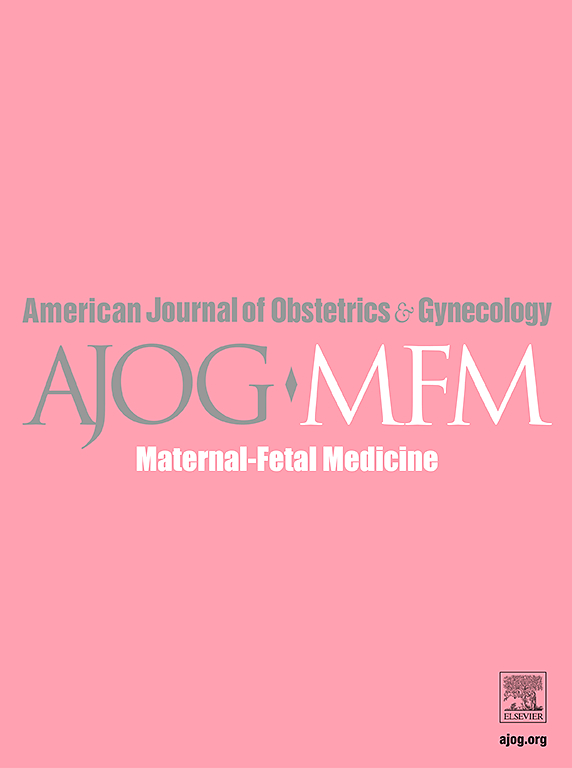A randomized controlled trial of propranolol in nulliparous patients with prolonged labor
IF 3.1
2区 医学
Q1 OBSTETRICS & GYNECOLOGY
American Journal of Obstetrics & Gynecology Mfm
Pub Date : 2025-05-09
DOI:10.1016/j.ajogmf.2025.101698
引用次数: 0
Abstract
Background
Propranolol use has been proposed to shorten the length of labor following prolonged induction.
Objective
We sought to determine if administration of propranolol reduces the duration of labor among nulliparous individuals with prolonged latent labor following induction (IOL) at term.
Study Design
An open-label randomized clinical trial was conducted from July 2019 through June 2022 comparing 2mg of intravenous propranolol administration to usual care for prolonged latent labor. Nulliparous individuals undergoing IOL at ≥37 weeks with a singleton gestation and cervical dilation ≤2cm were included. Prolonged latent labor was defined as no cervical change ≥8 hours with ruptured membranes and receiving oxytocin. Labor management was standardized among participants. Our primary outcome was time to delivery.
Results
80 nulliparous participants (40 propranolol, 40 usual care) were randomized. Propranolol administration did not achieve a significantly faster median time to delivery compared to usual care, (propranolol: 27.7 hrs vs. usual care: 30.4 hrs, P<.52). Equal proportions of individuals delivered vaginally within 24hrs of randomization (propranolol: 27.5% vs. usual care: 27.5%, P<1.0). There was no difference in the cesarean delivery rate between the 2 groups (57.5% versus 55.0%, P=1.0) and no difference in time to active labor (propranolol: 19.5 hrs vs. usual care: 26.0 hrs, P<.22). There were no significant differences in maternal and neonatal outcomes.
Conclusion
Propranolol administration did not shorten the time to delivery or increase vaginal delivery in nulliparous individuals with a prolonged latent labor course. Our findings do not support the use of propranolol for prolonged latent labor in nulliparous patients undergoing IOL at term.
普萘洛尔用于未产患者延长分娩的随机对照试验:普萘洛尔用于延长潜伏分娩。
背景:应用心得安可缩短引产时间延长后的产程。目的:我们试图确定普萘洛尔是否能减少足月人工晶状体(IOL)后潜伏期延长的无产个体的分娩时间。研究设计:2019年7月至2022年6月进行了一项开放标签随机临床试验,比较静脉注射2mg心得安与常规护理对长期潜伏分娩的影响。≥37周,单胎妊娠,宫颈扩张≤2cm,接受人工晶状体人工晶状体植入的未生育个体。延长潜伏产程定义为宫颈无变化≥8小时且膜破裂并给予催产素。参与者的劳动管理标准化。我们的主要结果是交货时间。结果:80例产妇(40例普萘洛尔,40例常规护理)随机分组。与常规护理相比,心得安的中位分娩时间并没有显著缩短(心得安:27.7小时,常规护理:30.4小时,p< 0.52)。在随机分组的24小时内阴道分娩的个体比例相同(心得安:27.5% vs常规护理:27.5%,p< 1.0)。两组剖宫产率差异无统计学意义(57.5% vs 55.0%, p=1.0),产程差异无统计学意义(心得安19.5 h vs常规护理26.0 h, p< 0.22)。产妇和新生儿的结局没有显著差异。结论:普萘洛尔不能缩短产程延长的无产个体的分娩时间或增加阴道产程。我们的研究结果不支持使用心得安治疗足月接受人工晶状体的无产患者的延长潜伏分娩。
本文章由计算机程序翻译,如有差异,请以英文原文为准。
求助全文
约1分钟内获得全文
求助全文
来源期刊

American Journal of Obstetrics & Gynecology Mfm
Medicine-Medicine (all)
CiteScore
7.40
自引率
3.20%
发文量
254
审稿时长
40 days
期刊介绍:
The American Journal of Obstetrics and Gynecology (AJOG) is a highly esteemed publication with two companion titles. One of these is the American Journal of Obstetrics and Gynecology Maternal-Fetal Medicine (AJOG MFM), which is dedicated to the latest research in the field of maternal-fetal medicine, specifically concerning high-risk pregnancies. The journal encompasses a wide range of topics, including:
Maternal Complications: It addresses significant studies that have the potential to change clinical practice regarding complications faced by pregnant women.
Fetal Complications: The journal covers prenatal diagnosis, ultrasound, and genetic issues related to the fetus, providing insights into the management and care of fetal health.
Prenatal Care: It discusses the best practices in prenatal care to ensure the health and well-being of both the mother and the unborn child.
Intrapartum Care: It provides guidance on the care provided during the childbirth process, which is critical for the safety of both mother and baby.
Postpartum Issues: The journal also tackles issues that arise after childbirth, focusing on the postpartum period and its implications for maternal health. AJOG MFM serves as a reliable forum for peer-reviewed research, with a preference for randomized trials and meta-analyses. The goal is to equip researchers and clinicians with the most current information and evidence-based strategies to effectively manage high-risk pregnancies and to provide the best possible care for mothers and their unborn children.
 求助内容:
求助内容: 应助结果提醒方式:
应助结果提醒方式:


